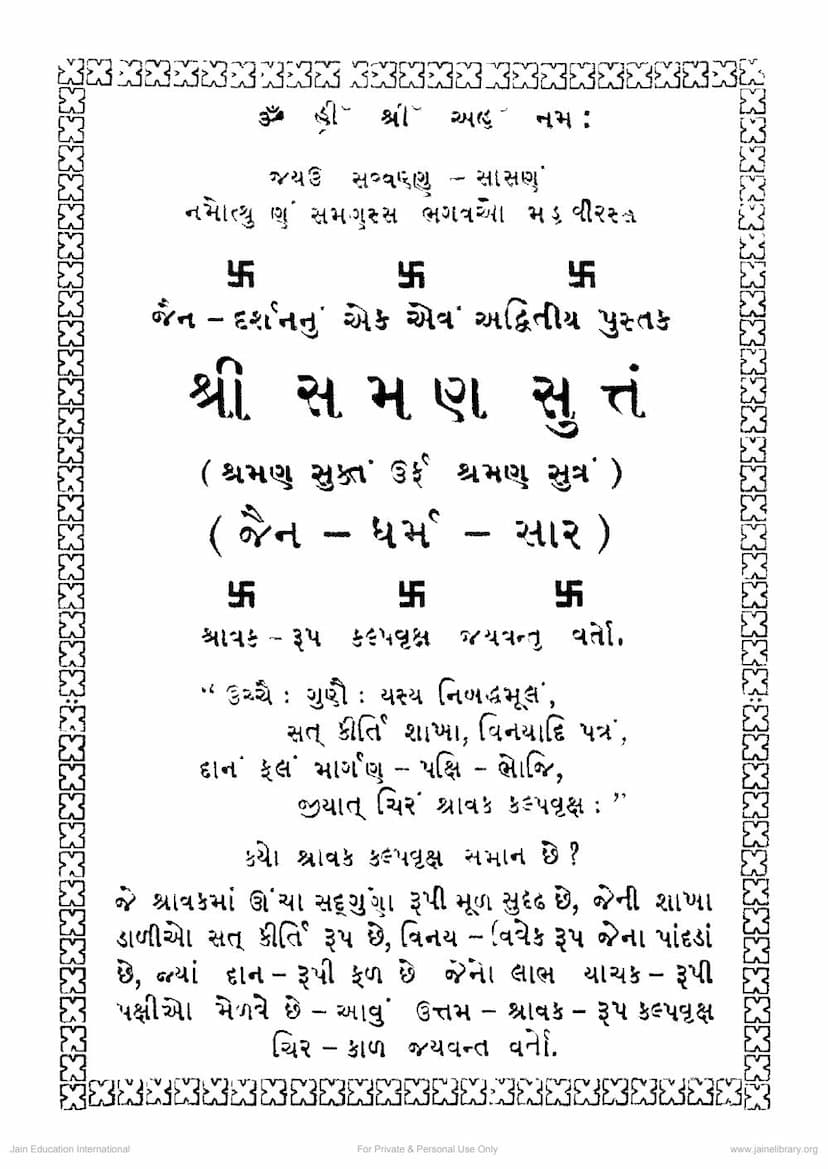Saman Suttam
Added to library: September 2, 2025

Summary
This Jain text, titled "Samana Sutta" (also referred to as "Shraman Sutta" or "Jain Dharma Saar" - Essence of Jainism), compiled by K. G. Shah and published by Pradeepbhai Sheth in Ahmedabad, is a profound exploration of Jain philosophy and ethics. The book, as evidenced by the provided pages, aims to present the core principles of Jainism in a comprehensive and accessible manner.
Here's a breakdown of the key themes and content presented in the excerpt:
I. The Ideal Jain Layperson (Shravak):
- The text begins by defining an ideal Jain layperson (Shravak) by comparing them to a Kalpa Vriksha (wish-fulfilling tree). This ideal Shravak possesses strong virtues as roots, branches of good reputation, leaves of humility and respect, and bears the fruit of charity, benefiting those in need (like birds benefiting from a tree).
II. The Path to Liberation (Moksha):
- The book emphasizes the Jain path to liberation through Samyak Darshan (Right Faith), Samyak Gyan (Right Knowledge), and Samyak Charitra (Right Conduct). This is presented as the "Moksha Marg" (Path to Liberation) as taught by Lord Mahavir.
III. Importance of Knowledge and Respect for Scriptures:
- A significant portion of the text is dedicated to the proper handling and respect for religious texts. It stresses the sanctity of knowledge and warns against its violation.
- Covering books properly.
- Not placing books on the ground.
- Avoiding spitting while turning pages.
- Not using books as pillows.
- Not eating or performing bodily functions near scriptures.
- The act of disrespecting knowledge or the learned leads to negative karma (Gyanavaraniya bandha) resulting in loss of memory, intelligence, and disrespect in future lives.
IV. Characteristics of a "Jani" (Wise Person):
- The text defines a "Jani" (wise person) as someone who has overcome attachment (Moh). Such a person finds worldly pleasures hollow, considers love equal to death, views miraculous powers as poison, and sees material wealth as insignificant. They are detached from worldly possessions and relationships, understanding their transient nature.
V. The True Meaning of Being Jain:
- The book challenges superficial adherence to Jainism, emphasizing that true Jainism lies in internal transformation rather than mere outward appearance or rituals.
- It stresses the importance of Guru's (spiritual teacher's) guidance without which one remains ignorant.
- True Jainism involves shedding karmic impurities, realizing one's true nature, and living a life free from sin.
- It criticizes those who are proud of their actions and actions alone without true knowledge.
- The essence of Jainism is seen in inner disposition and devotion to the soul's liberation.
VI. The Significance of Actions and Devotion:
- The text highlights that Moksha (liberation) is achieved through actions (Kriya), not just knowledge. Both are essential and interconnected.
- It emphasizes the importance of following the teachings of the enlightened ones (Jineshwar Paramatma) and practicing them with faith and wisdom.
VII. The Role of Parents and Reverence for Elders:
- The book dedicates significant space to the veneration of parents, highlighting their immense sacrifices and the debt owed to them. It encourages children to serve and honor their parents, considering them as living deities.
VIII. The Nature of the Soul and Liberation:
- The text asserts that the true goal is to know and experience the soul (Atma). All other knowledge is considered futile without self-realization.
- Liberation is attainable through equanimity (Samabhav), irrespective of one's sect (Shvetambar or Digambar) or beliefs. True Samayika (meditation/equanimity) is considered liberation itself.
IX. The Importance of "Jain" Principles:
- The acronym J.A.I.N. is presented, signifying:
- Just (Honest, righteous)
- Affectionate (Full of love and compassion)
- Introspective (Self-examining)
- Noble (Of high character)
X. Social Commentary and Critique:
- The book also touches upon societal issues, particularly concerning women's status and the disconnect between religious practices and societal realities. It questions the reverence shown to deities during festivals like Navratri when women face atrocities like dowry deaths.
- It critiques the commercialization of religion and the superficiality of certain religious practices.
XI. The "Samana Sutta" as a Comprehensive Work:
- The "Samana Sutta" is described as a monumental work compiled with inspiration from Acharya Vinoba Bhave. It aimed to create a universally acceptable text for Jainism, unifying different sects (Shvetambar, Digambar, Terapanthi, Sthanakvasi) during the 2500th birth anniversary of Lord Mahavir. It contains 756 verses divided into four Khandas (sections) covering Jain Dharma, philosophy, and conduct. The book is presented as a representative text for introducing Jain principles to the common person.
XII. The Compilation Process and Contributors:
- The book highlights the collaborative effort behind its creation, involving Munishri Akalankvijayji, Dalshukhbhai Malviya, and the compiler, Prof. K. G. Shah. It also mentions the financial support from Pradeepbhai Sheth.
XIII. Detailed Subject Matter:
- The extensive table of contents (Anukramanika) reveals the book's breadth, covering topics like:
- The Six Substances (Dravya) of Jainism.
- The Nine Tattvas.
- The concept of Karma.
- The nature of Maya (delusion).
- The importance of Right Faith, Knowledge, and Conduct.
- The stages of spiritual progress (Gunasthana).
- The doctrines of Syadvada (Anekantavada).
- The significance of various vows and observances.
- The nature of the soul and liberation.
- The essence of Jain teachings.
In essence, "Samana Sutta" appears to be a foundational text that attempts to synthesize the diverse philosophical and ethical teachings of Jainism into a cohesive and understandable framework, catering to both the scholarly and the devotional needs of its readers. The excerpt showcases a deep commitment to Jain principles, emphasizing both intellectual understanding and practical application in daily life.